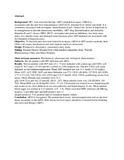Anti-Retroviral Therapy Related Liver Injury A Series of 11 Cases

View/
Date
2014Author
Otedo, A E O
Otieno, C F
Oyoo, G O
Omonge, EO
Language
enMetadata
Show full item recordAbstract
Background: HIV Anti-retroviral therapy (ART) related liver injury (ARLI) is
associated with elevated liver transaminases (AST/ALT), potential liver failure and death. It is commonly associated with nevirapine. Identification of pre- clinical risk factors is important in its management to prevent unnecessary morbidity, ART drug discontinuation and mortality. Hepatitis B and C viruses (HBV, HCV), nevirapine and protease inhibitors, low body mass index, low platelet count and deranged renal functions prior ART initiation are associated with development of hepatotoxicity.
Objective: To describe anti-retroviral-related liver injury (ARLI) in HIV positive patients, their CD4+ cell counts, biochemical and viral markers and liver ultrasound.
Design: Prospective, descriptive, consecutive entry study.
Setting: Kisumu District Hospital liver clinic/medical outpatient clinic, Nairobi
Rheumatology Clinic and Mater Hospital.
Main outcome measures: Biochemical, ultrasound and virological characteristics
Subjects: Eleven patients with HIV infection and ARLI .
Results: Eleven patients with M:F ratio of 2 : 9 were included with a mean age and CD4+ cell count of 36.5 years ( 27-45) and 69.3 cells/ìl (11-199) respectively. The low CD4+ cell count indicates severe immunosuppression. Mean ART duration use was 11.1 weeks (3-19 weeks). Mean AST, ALT, INR, ALP, and direct bilirubin was 273.1 IU/L (40-869), 337 IU/L (65-1030), 2.77 (2.27-3.9), 728.5 IU/L (352-2353) and 174.57 ìmol/L (59.0 -530.8) manifesting severe liver injury. Mean albumin and creatinine were 25.2
g/dl (16.0-32.4) and 162.25 mmol/L (69.8 - 247). Mean platelet count was 128.0X106/L (20-292). Mean BMI was 18.40 Kg/M2 (16.0 - 31.14). Ultrasound was normal in two, hepatomegally and ascites in six, liver cirrhosis in two and gallstones and hepatomegaly in one. Mean random blood sugar was normal at 5.23 mmol/L (3.9 - 7.4). Three cases had HBV infection (all HBsAg positive, 2 anti-HBc IgG and IgM positive and 1 e
antigen positive). Two patients died of fulminant hepatic failure.
Conclusion: ARLI is recognised. The patients had severe immunosuppression and severe liver injury secondary to the ARTs. Risk factors for liver injury should be evaluated before initiating anti-retroviral therapy (ART).
Publisher
University of Nairobi
Collections
- Faculty of Health Sciences (FHS) [10415]
